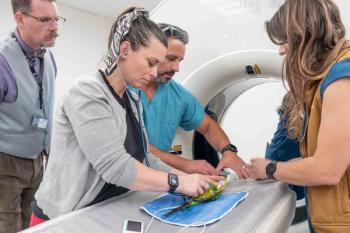
Radiography of bones: It's not just black and white (Proceedings)
The evaluation of the musculoskeletal system is difficult due to the numerous soft tissues as well as the bone structures involved. Rapid assessment of the bone structure is routinely performed using radiographs; however, the subtlety of disease and joint compared to bone pathology can be confusing.
The evaluation of the musculoskeletal system is difficult due to the numerous soft tissues as well as the bone structures involved. Rapid assessment of the bone structure is routinely performed using radiographs; however, the subtlety of disease and joint compared to bone pathology can be confusing. The purpose of this lecture is to cover the identification of aggressive compared to non-aggressive bone lesions as well as erosive compared to non-erosive joint pathology.
When evaluating the skeletal system, the first thing to determine is if the lesion is aggressive or non-aggressive. A non-aggressive lesion diagnoses include callous, malunion fractures, bone cysts, osteomas, osteochondritis dessicans, panosteitis, fragmented medial coronoid process, osteoarthritis or metabolic disorders. Aggressive lesions are due to neoplasia or osteomyelitis.
When deciding about aggressive lesions, there are 6 radiographic signs that are used: bone lysis, periosteal reaction, rate of progression, zone of transition, cortical lysis. Bone lysis has three different appearances, geographic (focal) moth-eaten and permeative. The difference between the degree of lysis is mainly on the rate of progression. It requires approximately 50% of the bone per unit area to be destroyed before it is visible on radiographs. This is because the bone is a three dimensional object viewed from two dimensions. Because of this, bone is superimposed on itself, making subtle lesions hard to detect. The more lysis that is present, the easier it is to see on radiographs. Also, by the time lysis is seen on a radiograph, the lesion is quite severe.
Periosteal reaction can either be smooth (continuous) or interrupted. The easiest way to determine this is if you could trace the outline of the periosteal reaction with a pencil and never have to lift the pencil from the radiograph. Smooth periosteal reactions are generally associated with trauma whereas interrupted periosteal reactions are due to an aggressive process.
Rate of progression is probably the most overlooked method to assess an aggressive lesion. By the time a questionable aggressive lesion is seen on a radiograph, the lysis is quite substantial. Therefore, the rate of progression in 2-4 weeks will also be dramatic. If a question exists between an aggressive and non-aggressive lesions, supportive medical management for 2-4 weeks then repeat radiographs to look for progression can aid in determining if the lesion is aggressive.
Zone of transition is a more nebulous sign, but the idea is that if a clear-cut demarcation between normal and abnormal bone is seen, then the lesion is more likely non-aggressive. If there is a long zone of transition, the difference between normal and abnormal bone is blurred and the lesion is more likely to be aggressive. In addition, cortical lysis as opposed to overall bone lysis can be used to determine aggressive bone lesions. If the cortex is thin, but no lysis is present, then it is more likely that the lesion is non-aggressive.
After determining these radiographic signs, the next clue is based on the location of the lesion. If the lesion is generalize in that it effects all bones equally, then the primary differential diagnosis is a metabolic or nutritional abnormality. If only one bone is involved, this is a focal or monostotic lesion and a primary bone tumor or soft tissue tumor with secondary bone involvement is considered most likely. If multiple bones in the same region (locally extensive), different bones that are not in close proximity or multiple areas in the same bone are involved, this generally indicates a hematogenous spread disease as bacterial osteomyelitis or metastatic neoplasia. A soft tissue tumor with secondary bone involvement is possible with locally extensive lesions, such as aggressive lesions that cross a joint.
Anatomic location is also a key into the differential diagnoses. If the lesion is epiphyseal or physeal in origin, then it is likely secondary to infection, trauma or potentially a nutritional abnormality. These lesions are generally in juvenile dogs and cats. If the lesion is in the metaphyseal region, then a primary bone tumor or hematogenous infection is most likely due to the proximity of the nutrient foramen. If the lesion is diaphyseal, then the lesion is likely metastatic neoplasia, a soft tissue mass with secondary bone involvement or a focal infection related to a penetrating trauma.
After all these signs and locations are taken into account, then the differential diagnoses are prioritized based on the signalment and history of the patient. A 2 year old hunting dog with an aggressive bone lesion in the proximal metaphysis of the humerus is more likely to have a fungal infection; however an 8 year old Rottweiler with the exact same radiographic findings is more likely to have osteosarcoma. These considerations should be made when assessing aggressive lesions. Since osteosarcoma is a common tumor type, it is not uncommon for clinicians to see an aggressive lesion, even if it is locally extensive and crosses a joint, and consider a primary bone tumor like osteosarcoma. However, other tumors such as malignant histocytosis, synovial cell (histocytic) sarcoma, or even fibrosarcoma, chondrosarcoma and metastatic neoplasia can all be considered possible. Biopsy (excisional or incisional), thoracic radiographs and history may aid in further prioritizing the lesion.
Lesions centered on joints are similar to those in bone. These lesions are centered on the epiphysis of both sides of the joint. Just as aggressive and non-aggressive lesions exist in bone, erosive and non-erosive lesions are in joints. A non-erosive lesion is osteoarthritis. Everything else is considered erosive. Osteoarthritis is a degenerative condition due to joint instability or trauma. It is characterized by the presence of osteophytes and enthesiophytes. An osteophyte is smooth bone production within the joint capsule that serves as a buttress to tighten ligaments and stabilize the joint. Enthesiophytes are bone production at the attachment of the joint capsule and ligaments due to abnormal tension that is present on the soft tissues from joint instability.
Erosive lesions in small animals are usually infectious and mostly autoimmune in origin. Causes of erosive arthropathy also include chronic hemarthrosis or neoplasia, but these are less likely in small animals. Just as with bones, joint lesions are characterized by the number involved. A monoarthrosis (one joint) is usually osteoarthritis or a traumatic infection, such as a puncture wound. A polyarthropathy (multiple joints involved) usually indicates a hematogenous infection or immune mediate disease.
The radiographic signs for an erosive arthropathy include subchondral bone lysis, presence of osteoarthritis, decreased joint space (especially when weightbearing), luxation or subluxation of the joint and fragmentation of adjacent bone. Based on these signs, and the presence of one or multiple joints involved, a arthrocentesis can be performed to determine the cause for the erosive arthropathy.
Radiographic findings of joint an bone lesions can be confusing if one does not consider the vast number of differential diagnoses possible and then makes an educated decision to prioritize the lesion. This is generally done by the clinician automatically due to the geographic location and the likelihood of disease in a given area. If a dog in southern Michigan presents to Michigan State University for an aggressive bone lesion, neoplasia is more likely. However, if the patient is from northern Michigan, then fungal osteomyelitis should be considered possible. At the end of this lecture the hope is that the veterinarian will have numerous examples and a better overall appreciation of how to evaluate a radiograph for aggressive and erosive lesions.
Newsletter
From exam room tips to practice management insights, get trusted veterinary news delivered straight to your inbox—subscribe to dvm360.






